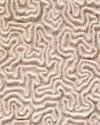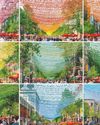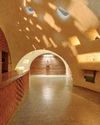Architecture
Domus India
Patrick Berger - Jacques Anziutti
THE CANOPY, PARIS Since the demolition in 1971 of the 19th-century pavilions designed by Victor Baltard for the central markets, the area of Halles has been through various building stages, some rather tormented. Now, with the grand architectural gesture of the Canopy, the work of two French architects has given new meaning from an urban point of view to this central place, resolving the complexity of its social, cultural and infrastructural functions
4 min |
December 2016

Domus India
Vincent Van Duysen
MERGING DESIGN AND ARCHITECTUREStarting from his new projects for Molteni&C, where he has just become art director, and for Flos, the Belgian architect Vincent Van Duysen explains to Domus his approach to design. This takes architecture and design as a single discipline focused on human needs – it starts from the design of the place and continues to the furniture and the objects which surround us and which we need for a satisfactory life.
5 min |
December 2016

Domus India
Time, Politics, and Housing
A recent exhibition on housing in India uses discourse as a tool to addresses the concepts of living and dwelling in a constantly evolving urban-rural continuum
6 min |
April 2018

Domus India
Economy And Cultural Production
Andrea Phillips talks to Martina Angelotti about a different way of interpreting the concept of value in the cultural field
8 min |
April 2018

Domus India
Studio Formafantasma Ore Streams
Studio Formafantasma turns scrap into a resource and confirms that design can play a crucial part in issues in which our planet’s future is at stake.
4 min |
April 2018

Domus India
Frank Lloyd Wright: Unpacking The Archive
In 2012, the Museum of Modern Art in New York – with the Avery Architectural & Fine Arts Library of Columbia University – acquired the Frank Lloyd Wright Foundation archive. Now it is holding a major retrospective to commemorate the great American architect’s birth 150 years ago. We asked Kenneth Frampton to talk about the exhibition.
4 min |
December 2017

Domus India
Designing A Disobedient Show For An Unruly Space
An ongoing exhibition throws light upon ceramic and clay objects made by hereditary and studio-trained potters as well as artists — and their histories — that have never, or rarely, been measured and mapped. Held in a repurposed space of an office building in a corporate park in central Mumbai, it appropriately illustrates the challenges involved in the process of exhibition-making in an ‘unruly’ space; highlights the experience of the art-viewer; and discusses the notion of spatial possibilities in ‘alternate museums’
10+ min |
December 2017

Domus India
Enzo Cucchi Fountain Of The Two Suns Ancona
The use of what was already there seems to have been the thinking behind the fountain added by the artist to the splendid setting of the port of Ancona, presented here in the masterly words of Francesco Merlo, who describes its landscape, imagery and fa-ti-ca.
5 min |
December 2017

Domus India
On Valerio Olgiati
A new book on the work of Valerio Olgiati was recently published. Here we feature an excerpt from the volume’s afterword by Jacques Lacan, who delineates the Swiss architect’s figurative approach.
3 min |
Febuary 2018

Domus India
The Intimacy Of Everyday Space
A recent exhibition highlights a suite of work of eminent artist Sudhir Patwardhan, comprising over 80 portraits as well as studies of the personal space, that is, his home studio. In conversation with artist Jitish Kallat, Patwardhan discusses the notions of ageing, companionship, routineness, and the passage of time, and reflects upon why navigating the enclosed, private space is central to his practice.
10+ min |
Febuary 2018

Domus India
A Template For Minimal Living
Located on a small site in the town of Belgaum, the design and construction of Stacked Student Housing highlights the architects’ attempt to make maximum yet judicious use of minimum space without compromising on the quality of space. While the optimisation of resources ensured the project’s completion within its modest budget, the masterful spatial articulation is perhaps its key attribute.
6 min |
Febuary 2018
Domus India
Inagawa Cemetery Chapel And Visitor Centre
The unusual topography and terracing of a cemetery in the mountains north of Osaka dictate the nature and proportions of its new architecture. The design of the roof defines the surrounding geometries and coloured concrete heightens the sense of permanence.
2 min |
Febuary 2018

Domus India
The Stone- Eating Worm
“Between the conception And the creation Between the emotion And the response Falls the shadow.” Thomas Stearns Eliot, The Hollow Men, 1925
3 min |
August 2018

Domus India
Sculpting Temple Design
Believed to have been constructed sometime between the 11th and 12th centuries CE by the then reigning Parmar and Chauhan rulers, the temples of Kiradu are located remotely, west of Barmer in Rajasthan. Known as the ‘Khajuraho of Rajasthan’ by the locals — and currently in a state of ruin owing to deliberate destruction and the ravages of nature — they now stand mute testimony to the passage of time, to the rise and fall of dynasties and their fortunes
6 min |
August 2018

Domus India
A Secret Agent In Bangkok
Six wooden huts stand in the heart of the Thai capital. Tracked down in the 1950s and 1960s by Jim Thompson on his travels, they were dismantled and constructed to try and preserve what was being lost.
2 min |
August 2018

Domus India
Hudson Yards West Side New York City USA ​​​​​​​
A conversation with Justin Davidson
7 min |
August 2018
Domus India
Koodaaram: The Pavilion At Cabral Yard, Kochi
During the Kochi-Muziris Biennale, an open structure inspired by the traditional Koothambalam served as a space for performance and lectures as well as one for conversations, to exchange thoughts and ideas, and engage in debate and discussion.
7 min |
May 2019

Domus India
Long, Sunlit Days
As summer sets in, far too firmly, with long, hot days and not enough respite after sunset, I turn the air-conditioning on, seeking solace in Scandinavian summers, with Karl Ove Knausgaard’s fourth installment of the season’s quartet: Summer.
6 min |
May 2019

Domus India
In This Room, The Poems Come And Go
Poems by Sarabjeet Garcha Section curated by Ranjit Hoskote Photographs by Chirodeep Chaudhuri
5 min |
May 2019

Domus India
Humour, Please
Claude Cormier is a Canadian landscape architect who intervenes in cities with a precise intent: to create beauty
4 min |
May 2019
Domus India
Room For Diversity
Discrimination and inequalities should be out!
3 min |
May 2019
Domus India
Tribute
Darryl D’Monte (1944-2019)
4 min |
May 2019

Domus India
Context And Memory Are Complex Propositions
On many recent occasions – at conferences, panel discussions, private conversations at work as well as discussing student-works at the academy, the complex nature of what architectural language should be seems to be coming into focus constantly.
5 min |
October 2016

Domus India
Lightness Of Being
Two projects – one, a rehabilitation of a place of significant historical importance and the other a city house – both in the dense urban milieu of Pune, explore the use of mass and light; light not only through illumination, but also through the inversion of visual weight by inventive spatial and tectonic moves.
6 min |
October 2016

Domus India
In The End: Architecture
After having founded and directed the Architekturzentrum Wien for over 20 years, Dietmar Steiner steps down with an exhibition, a conference and a publication covering the most important stages in the career of this internationally acclaimed architect, researcher, critic, publicist and curator, who for 60 years has been a key player in the field.
2 min |
April 2017

Domus India
Fold / Unfold
Through a recently-concluded solo exhibition, artist Sonia Khurana explores the motifs of interiority and embodiment, and gathers several ‘vignettes across time that place the body in an oblique relation to diffused feminist aesthetics of the counter-spectacle and performative resistance’
6 min |
April 2017

Domus India
Somaya & Kalappa Consultants It Campus For Tata Consultancy Services Indore, Madhya Pradesh
Designed with water bodies and plenty of green areas, an IT campus in Indore seeks inspiration from the river Narmada that flows through Madhya Pradesh.
10+ min |
November 2018

Domus India
The Demon's Tears: Water And Worship At Lonar
Formed due to the impact of a meteorite, the Lonar Lake — located in the Buldhana district of Maharashtra — is surrounded by numerous temples, a majority of them in ruins. These temples are probably a reminder of the eternal cycle of life and death, and of the essential sacredness of the site, over the lake itself.
6 min |
November 2018

Domus India
Djibouti. Flexibility And Tribal Values
In the Horn of Africa, the idea of the home often takes the form of an open space; the house is a place of collective appropriation.
2 min |
November 2018

Domus India
The Silence Of Our Gods
Silence is not only a passive condition but a creative opportunity to construct our space, our representations and ourselves.
3 min |
